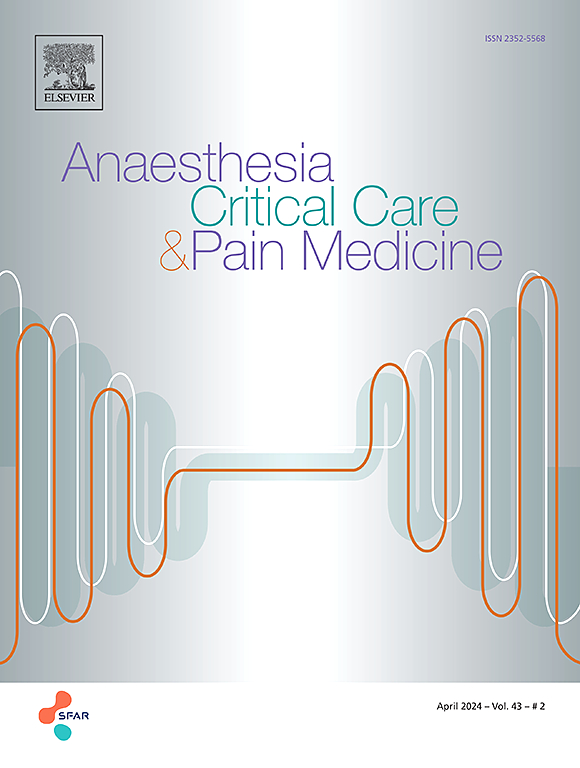Association between arterial carbon dioxide tension and poor outcomes after cardiac arrest: A meta-analysis
IF 4.7
3区 医学
Q1 ANESTHESIOLOGY
引用次数: 0
Abstract
Background
Abnormal arterial carbon dioxide tension (PaCO2) is a common finding after cardiac arrest (CA). Inconsistent results regarding the association between abnormal PaCO2 and poor outcomes have been reported previously. We performed a meta-analysis to evaluate whether hypocapnia or hypercapnia is associated with an increased risk of hospital mortality and poor neurological outcomes in adult patients with CA.
Methods
PubMed, Embase, and the Cochrane Library databases were searched through October 2024 to determine studies investigating the association between PaCO2 and the risk of hospital mortality and/or poor neurological outcomes in adult patients with CA. A random-effects model was used to calculate the pooled odds ratio (OR) with 95% confidence intervals (CIs) for cohort studies and relative risks (RRs) with 95% CIs for randomized controlled trials (RCTs).
Results
A total of 14 cohort studies and 3 RCTs comprising 72344 patients were included. Pooled analysis indicated that hypocapnia was associated with an increased risk of hospital mortality (nine cohort studies, OR 1.37; 95% CI, 1.18–1.59; P < 0.0001) and poor neurological outcomes (five cohort studies, OR, 1.75; 95% CI, 1.04–2.96; P = 0.035). Within cohort studies, hypercapnia was associated with increased risk of hospital mortality (10 trials, OR 1.40; 95% CI, 1.13–1.73; P = 0.002), but not associated with poor neurological outcomes (six cohort studies, OR, 1.57; 95% CI, 0.87–2.83; P = 0.130). Within RCTs, mild hypercapnia was not associated with an increased risk of poor neurological outcomes after CA.
Conclusions
Current evidence indicated that hypocapnia was associated with an increased risk of hospital mortality and poor neurological outcomes after CA; however, hypercapnia was associated with an increased risk of hospital mortality but did not appear to be associated with increased poor neurological outcomes after CA.
Systematic review protocol
INPLASY 2024100120. Registered 28 October 2024.
动脉二氧化碳浓度与心脏骤停后不良预后的关系:一项荟萃分析
背景:动脉二氧化碳浓度(PaCO2)异常是心脏骤停(CA)后的常见发现。关于PaCO2异常与预后不良之间关系的不一致的结果已被报道过。我们进行了一项荟萃分析,以评估低碳酸血症或高碳酸血症是否与成年ca患者医院死亡风险增加和神经预后不良相关。和Cochrane图书馆数据库检索到2024年10月,以确定研究PaCO2与成年CA患者住院死亡率和/或神经预后不良风险之间关系的研究。使用随机效应模型计算队列研究中95%置信区间(CIs)的合并优势比(or)和随机对照试验(rct)中95% ci的相对风险(rr)。结果共纳入14项队列研究和3项随机对照试验,共纳入72344例患者。汇总分析表明,低碳酸血症与住院死亡风险增加相关(9项队列研究,OR 1.37;95% ci, 1.18-1.59;P < 0.0001)和较差的神经预后(5项队列研究,OR, 1.75;95% ci, 1.04-2.96;p = 0.035)。在队列研究中,高碳酸血症与医院死亡风险增加相关(10项试验,OR 1.40;95% ci, 1.13-1.73;P = 0.002),但与神经预后不良无关(6项队列研究,OR, 1.57;95% ci, 0.87-2.83;p = 0.130)。在随机对照试验中,轻度高碳酸血症与CA后不良神经预后的风险增加无关。结论:目前的证据表明,低碳酸血症与CA后医院死亡率和不良神经预后的风险增加有关;然而,高碳酸血症与住院死亡风险增加相关,但似乎与ca后不良神经预后增加无关。注册于2024年10月28日。
本文章由计算机程序翻译,如有差异,请以英文原文为准。
求助全文
约1分钟内获得全文
求助全文
来源期刊

Anaesthesia Critical Care & Pain Medicine
ANESTHESIOLOGY-
CiteScore
6.70
自引率
5.50%
发文量
150
审稿时长
18 days
期刊介绍:
Anaesthesia, Critical Care & Pain Medicine (formerly Annales Françaises d''Anesthésie et de Réanimation) publishes in English the highest quality original material, both scientific and clinical, on all aspects of anaesthesia, critical care & pain medicine.
 求助内容:
求助内容: 应助结果提醒方式:
应助结果提醒方式:


